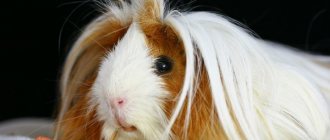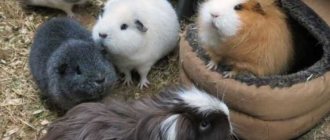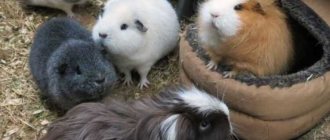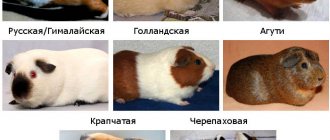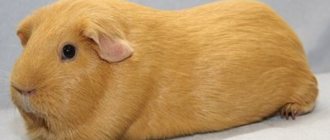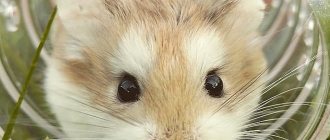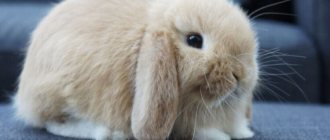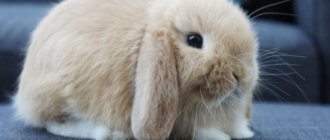Kui is a breed of guinea pig with gigantic size compared to its smaller relatives. It is precisely because of its impressive dimensions that in some countries, kui are bred for tasty meat. But there are many avid guinea pig lovers who are willing to keep the guinea pig as a pet.
The huge pig comes from Peru. In this country, you can find wild kuya of various colors, as well as see many nurseries for breeding giants. The rate of weight gain of a giant pig reaches one and a half kilograms in 4 months. And since there are problems with food in Peru, it’s time that cuy replaced rabbits and became one of the sources of meat in the country.
Origin
The largest guinea pig in the world comes from South America. In Peru, Bolivia, Ecuador, and Colombia it lives in the wild. Favorite habitats are rocky and mountainous areas, where the animal can find a lot of vegetation, as it is a herbivore.
They live in flocks of about 9–10 individuals. This makes it easier to survive and protect offspring from attacks by predators. The pack has a leader - the largest male.
Outside its homeland, the kui guinea pig gained fame in the middle of the last century.
In Peru, in places where the breed is widely inhabited, its cultivation is promoted to solve the food problem. The second purpose is natural fertilizers, which are obtained from animal excrement.
Such “values” are not of interest to Kui breeders in other countries. They are trying to tame animals. So far there has been no particular success.
Anatomy, appearance
The huge Kui guinea pig differs in size: a massive skeleton, a wide skull. There are individuals who have extra toes on their paws. Although polydactylism is considered an anomaly, it does not affect the health of the cat. The weight of a rodent can reach 4 kg. Average weight 2 kg.
The hind legs are large, the body is stocky, the forehead is wide. The length of the body of the kui is about 40 cm.
These pigs are classified as smooth-haired breeds. The color can be different: one-color, two or three colors.
Several varieties of kui have been developed. In European countries, the Creole breed is preferred for home keeping in apartments. These pigs have an elongated body and muzzle. They don't gain much weight. The Peruvian Longhair breed is bred as a decorative species. Very beautiful merino. Their fur is curled, like that of sheep.
Choosing a cage: is it suitable?
Experts advise building an enclosure as an alternative to a cage. The height of the cage or enclosure should correspond to the height of the animal, so as not to make it difficult for it to stand up to its full height. It is undesirable to install an additional house inside the cage; the animal is prone to solitude, and with a house it is more difficult to tame the rodent.
It is recommended to have a maximum of two same-sex individuals in an apartment. Reproduction is allowed only in an aviary.
The home of a hamster or guinea pig should be located away from radiators, heaters and drafts. Constant exposure to direct sunlight is also undesirable. The best temperature for a comfortable stay is 16-20 C; a climate that is too hot or cold can have a detrimental effect on the health of the animal. If you decide to get an enclosure, you need to take care of heating your pet in the winter.
Complex nature
Kui owners, who have kept these animals since birth, resort to various tricks to tame the obstinate animal. This is very difficult, since an aggressive and naturally distrustful animal constantly shows its genetic tendencies, which are aimed at survival in this world.
You can’t be offended by animals, because in the wild, herbivorous animals with short legs always need to keep their eyes open. Once you scare a nervous kui at least once, your efforts to cultivate friendliness are dashed against a wall of mistrust. Even experienced guinea pig breeders cannot boast of being friends with kui.
There is another feature of the breed. If small relatives of a large pig need to be kept in pairs, then here the guinea pig is aggressive towards such a neighborhood.
Animals often start fights. Females are more conflicted than males.
Which one is better to choose?
Before purchasing these interesting rodents, you should definitely learn everything about them. It is very important to take into account their character, what they eat, and how they should be cared for. And only after that determine the most acceptable option for yourself.
Many people want to get a very rare animal that they can not only show off to their friends, but also participate with in various exhibitions. However, it is also necessary to remember that for mating you will need a partner of the same breed. Only in this case will the guinea pigs be purebred.
Hairless breeds of pigs are quite popular. But when buying them, you must also take into account the fact that they are very sensitive to temperature changes and also require increased attention. In addition, their price will be high. Most often they are chosen by people suffering from allergies or families with small children.
Not too rare breeds will be no less beautiful and popular. For example, when buying smooth-haired pigs, a person makes it easier to care for them. These animals also have a more developed immune system. But those who decide to get long-haired pets should know that they will also need to be brushed, and this takes more time. Yes, and they cost a little more.
When choosing guinea pigs, you also need to know what they should eat. After all, not only their appearance, but also their health will depend on this.
To summarize, guinea pig breeds are quite diverse. Therefore, you can choose an animal to suit every taste. But when choosing an animal for yourself, you must also remember that this pet will require constant attention and care from a person. Only in this case will the pet love and understand its owner, and the owner himself will receive many joyful moments, because guinea pigs are incredibly funny and interesting.
For information about what a beginner needs to know about guinea pigs, watch the following video.
Features of selection
Animals develop quickly. Sexual maturity occurs at 3–4 months.
To catch a favorable “moment” for breeding, breeders select the youngest females before they get fat. Once the animals gain excess weight, they are not suitable for procreation. It is extremely dangerous for overweight animals to carry babies.
To get healthy offspring, the pedigree of the animal is carefully studied. It is necessary to take into account the weight that your ancestors had. They try to find couples who are not prone to obesity.
Under no circumstances should large cuis be mixed with representatives of other breeds for procreation. Such “amateur activity” in selection will lead to congenital anomalies in the cubs. The animals will be very sick and most likely will not survive.
A newborn baby can weigh more than 0.1 kg. If a female is diagnosed with obesity, then she will not be able to cope with such a birth.
Guinea pigs with long hair
Peruvian
Peruvians are the pioneers of these cute, long-haired animals. Selection for their breeding began already in the 1800s in Europe. The long, thin fur of pets falls on the sides and on the head. Therefore, if the pig is not a show pig, the “bangs” can be trimmed, otherwise they can be tied up or pinned. Breed standards require only a straight coat, without curls, and two rosettes - on the rump and head, near the nose. Their character is much calmer than that of other representatives; they can sit on their hands for a long time.
Sheltie and Coronet
Shelties can rightfully be considered the most pleasant to the touch. Compared to the Peruvian, the silky representatives do not have a parting on the back, the fur falls back. True shelties should not have any rosettes, and the covering on the head is much thicker, creating a kind of mane. Like many long-haired guinea pigs, they also have a calm temperament. But Coronets are rightfully the most active among the longhaired ones. They are distinguished by a single rosette on the head, the glossy long fur from which falls beautifully on the sides without covering the face. Pets that do not participate in exhibitions are usually cut into a bob so that the coat does not become dirty. It took much longer to produce modern Coronets than the breeds described above. To understand for yourself which guinea pig is the best of the breeds with such a hairstyle, you should pay attention to the character. The most peaceful and slow are Peruvians and Shelties, the most active and playful are Coronet. But the latter can also sometimes be in a phlegmatic mood.
On the left - Peruvian, in the middle - Sheltie, on the right - Coronet
Rules of care and maintenance
The large guinea pig is not widely distributed due to its complex nature and short life expectancy. And finding a purebred animal is not so easy.
If you decide to have a kui as a pet, you need to take into account the peculiarities of keeping it in captivity and know how to feed it correctly.
The maintenance and care rules are as follows:
- Your pet needs to purchase a spacious cage, at least 1.5 square meters. m.
- An enclosure for walking is set up next to the cage, at least two meters in length.
- The bottom of the cage should be made of plastic and covered with sawdust with a layer of 10 cm.
- Once every 10–15 days, the animal should be bathed in a basin of warm water using zoo shampoos.
- Once every 5–6 months, the animal’s claws are trimmed with special tweezers.
- All bedding in the cage should be changed at least once every 3 days, and the places that the rodent has chosen for the toilet should be changed daily.
- Feeding should be moderate. The diet should consist of fresh hay, vegetables, herbs, and fruits.
It is necessary to provide the kui with fruit twigs and mineral stones for grinding down teeth.
You cannot feed your pig porridge, mixed feed and grain. This will be a disservice. She will quickly get fat and get sick.
Nutriaceae
Nutria Photo: pixabay.com Nutria. It looks like a rat, up to 60 cm in length, weight up to 10 kg. It is a semi-aquatic animal; the structure of its mouth and nose allows it to feed underwater. She swims and dives well. The fur is thick, waterproof, brown with a yellow tint. In nature it lives for 4-6 years, in captivity - up to 10 years.
Nutria must be provided with the opportunity to swim and bathe. The water needs to be changed very often: nutria will not swim in dirty water, much less drink it. It is necessary to build her a house. In nature it is active mainly at night.
- Food: stems and leaves of reeds and cattails, reeds, water chestnuts, water lilies and other aquatic plants. He rarely eats animal food (fish, leeches, shellfish).
Nutria is quickly tamed. Breeds well in captivity. Lives in groups or pairs.
( 1 rating, average 5 out of 5 )
Additional information about the breed
A large guinea pig is not intended to be kept as a pet. It is difficult to play and “communicate” with such an animal. Therefore, you should not buy it for a child.
A pig can show a wild temperament and bite a person. Therefore, there is no need to provoke such actions. If you decide to have such a pet. It must be handled with care and gentleness despite its large weight and dimensions. The animal is nervous and extremely sensitive to voice intonations. If he senses aggression or danger, he will immediately react by running away or trying to defend himself.
It is convenient to purchase a large pig if you can keep it in a yard with a large enclosure and a covered house in a cage.
Natural enemies of skinny
Photo: What skinny looks like
Skinnies have no natural enemies, as they are domestic animals. Skinnies are more vulnerable to elements and factors that cause their health to deteriorate. They are sensitive to low and high temperatures. They should be placed in a room with normal room temperature. Feeding skinnies properly and placing them in a moderate temperature room allows them to maintain a normal body temperature.
Because they lack hair, they are more vulnerable to injury, infection, and skin lacerations. Skinnies with exposed skin should be handled with care as they are extremely vulnerable to injury and infection. Therefore, as a necessary precaution, they should be stored indoors in a controlled environment. They should be introduced to sunlight, but from then on, their playful and curious nature must be monitored. They may end up causing injury to their delicate bodies.
Their most significant difference is that skinnies must be kept indoors. Due to their lack of fur, they have trouble maintaining body heat when they are in cooler environments. They also do not cope well with drafts. Skinny bedding should be soft and free of sharp objects and surfaces. They are truly sensitive and any minor vulnerability they encounter must be addressed to ensure their overall safety.
